 9 cruisers (1964-1995):
9 cruisers (1964-1995):Belknap, J. Daniels, Wainwright, Jouett, Horne, Sterett, William Standley, Fox, Biddle (DLG-26 to 34).
US Cold War Cruisers:
Worcester | Des Moines | Juneau | Boston | Galveston | Providence | Albany class | Long Beach | Leahy | Belknap | Bainbridge | Truxtun | California | Virginia | Ticonderoga | Strike Cruiser (CSGN)The Belknap class cruisers were initially conceived as smaller, cheaper version of the Charles F Adams. However as the project evolved they ended as single-ended guided-missile cruisers (missile forward) unlike the previous Leahy class, but borrowed their hull when built still as destroyers leaders (DLG, then DDG) in 1963-67 or even frigates but cruisers from 1975 (numbered CG-). Ten ships were planned, but just like for the previous belknap, the last one, here USS Truxtun was stretched to install a nuclear reactor, augmenting the US fleet of one more nuclear-powered cruisers (with Bainbridge and Long Beach) whereas a fully fledged class of nuclear double ended cruisers was envisioned later. The Belknaps arrived just in time for the Vietnam war, escorting the 7th fleet carriers and guarding them againt NVAs migs. They were also prominent in all Mediterranean and Middle east crisis of the seventies and eighties and took part in the gulf war, being decommissioned in 1993-95. #usn #usnavy #unitedstatesnavy #missilecruiser #belknap #belknapclass
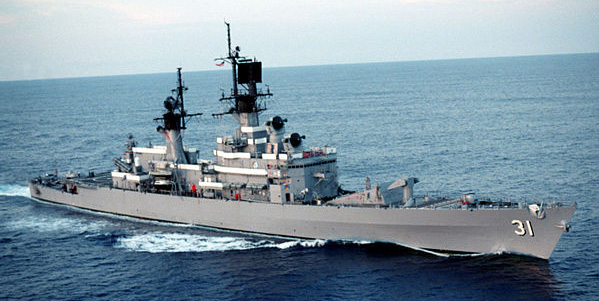
USS Sterett, CG-31
Development
The Belknap class were “fleet escorts” originally intended to be cheaper versions of the Charles F. Adams destroyers. Their ASW suite had to be improved and their range of action ported to 6000 nautical miles. Eventually studies led to even more expensive ships. It was decided to replace the Tartar missile with the less expensive Terrier system, one same Leahy hull design. Finalization resulted in a combination of the ASROC system and Terrier, with 60 or a 40 Terrier drum plus 20 ASROC drums combined in an early VLS. The missile range was initially 32 km, Mach 3 and 24,000 meters cailing. The Terrier was carrying a classic fragmentation 100 kgs warhead or nuclear, yeld 1 Kt. These ships stayed designated “fleet escorts” and then “cruisers in 1970 with ten built, the first launched in 1963 and last admitted on active service in 1967. Another indication of their initial destroyer classification th naming tradition, cities for cruisers, names for officers or public figures playing a role for navy.
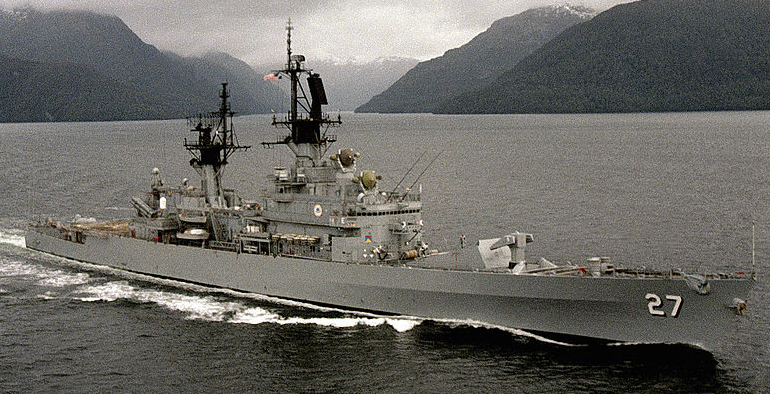
USS Josephus Daniels CG-27
Design of the class
The Belknap class shared a lot in appearance with the previous leahy class and they were indeed closely matched. Same design essentially of “single ender”, designed in stark contrast to the previous ww2 vintage cruisers conversions, ships that were enormously costly to maintain and operate. The new vessel earned the denomination of cruisers in 1975, but back then in 1960 they were classed as Frigates due to their relatively small size, especially compared to the firsts. They were however much larger than the usual ASW frigates such as the comtemporary Knox class.
When commissioned, they still had the same 5-inch/54-caliber Mk. 42 gun on the quarterdeck. But the innovation resided in their unique twin-rail RIM-2 Terrier Mk 10 Missile Launcher on the foredeck. This was the Makr 10 Mod 7 launcher, which for the first time was able to launch both the Standard and the RUR-5 ASROC, eliminating need for a separate Mk 112 ASROC box launcher. Unofficially they were named “Ter/AS” (“tear-ass”) launchers. Interestingly enough, upon the same insistence of President Kennedy for other ships, they were armed with two twin 3″/50 AA guns for close defence against sub-sonic aircraft and helicopters.
Hull and general design
The hull and superstructures were basically the same as the former Leahy class, in a “two islands” configuration, long forecastle and hull knuckle close to the clipper style bow without bulwarks. The hull was large and rectangulat almost down to the semi-transom (rounded) stern. They were however larger than the previous Leahy class, in displacement the Belknaps reached 5,409 tonnes standard and 7,890 tonnes fully loaded versus 5,146 tonnes standard and 7,590 tonnes FL for the Leahy. In dimensions, the Belknaps reached versus 159.8 meters long at the waterline and 166.8 meters overall versus 155.5 and 162.5 meters respectively for the Leahys.
In Breadth, they reached 16.7 meters versus 16.3 meters, so quite bearmier ships. In Draught too, they reached versus 5.80 meters versus 5.50 meters on the leahys.

Conway’s Profile of the Belknap
The bridge structure was designed the same way, with still two tall macks, combined funnels and masts. The superstrcutures were built in aluminium to improve stability by lowering the metacentric height. However this choice proved problematic as shown during Leahy’s grave collision with USS JF Kennedy. Aluminium burned far more fiercely and rapidly compared to Steel. The fire that started on USS Leahy soon spread to such an extent it became quiockly overwhelming and untollable. She had to be abandoned, and the superstructure eventually collapsed. Damage cause by fire costed far more than the damage resulting from the collision itself. This came as such as shock the Navy decided against using this material for structures if its next classes. The Ticonderoga still retained aluminium as the nuclear-powered California-Virginia classes and the Spruance. The Arleigh burke was the first class to come back to full steel (and composites).
So potentially this whole generation of 1960-70s ships were at risk of burning easily in case of war and hits…
Powerplant
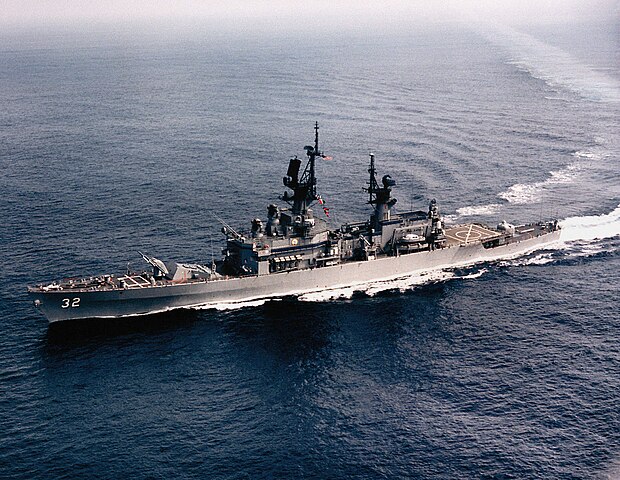
USS William H Standley in hard turn off San Diego 1985
The standard was two shafts geared steam turbines, fed by four 1200 psi (8300 kPa) boilers, for a total of 85,000 shp (63,384 kW). But this diverged between ships:
DLG26 and 27 (): Had two sets of General Electric geared steam turbines and four 4 Combustion Engineering boilers
DLG28, 32, 34 (): same but four Foster-Wheeler boilers
DLG29-31, 33 (): Two sets De Laval geared steam turbines, and four Combustion Engineering boilers
This enabled comparative tests for the best configuration.
Top speed was 32 knots (59 km/h) in best conditions, reached on trials.
Range was dictated by their oil storage, of 1,800 tonnes, for an endurance of 7,100 nautical miles () at 20 knots cruise speed. Largely enough to cross the atlantic into the eastern Mediterranean, circumnavigate south America, or reach distant points in the pacifc from Pearl Harbour.
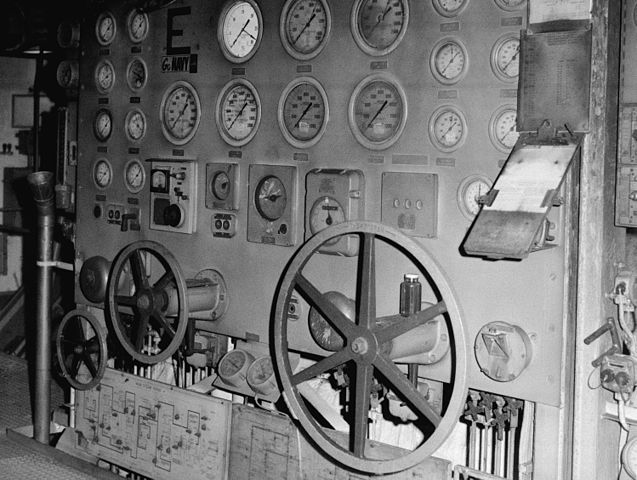
N°2 engine room throttle board
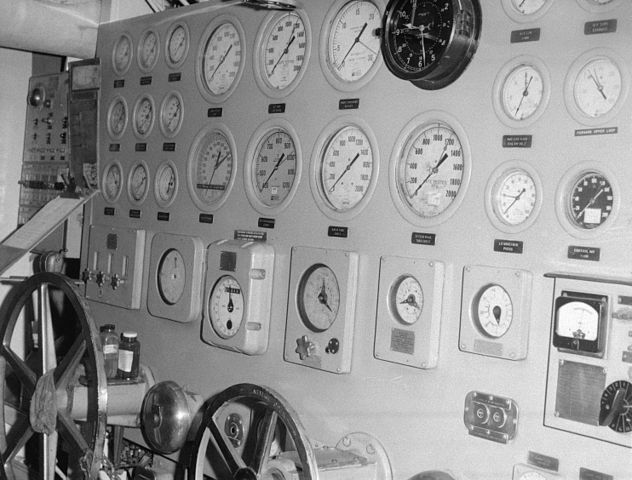
N°1 engine room main control board
Armament
Mk 10 Mod 7 Guided Missile Launching System
The universal launcher was replacing the former RUR-5 box launcher of the Leahy. It could fire 40 SAMs and 20 ASROC in sucession. There was a coimplex conveyor belt behind at two levels to enable both missile types to be loaded on whatever arm of the launcher through the same final loading hatches.
This system was used for the RIM-2 Terrier and later the RIM-67 Standard Missile SM-1/2ER on the Belknap class CG, Leahy class CG, Farragut (Coontz) class DDG Italian Navy Andrea Doria class and Vittorio Veneto helicopter cruiser.
RIM-66 Terrier SAM:
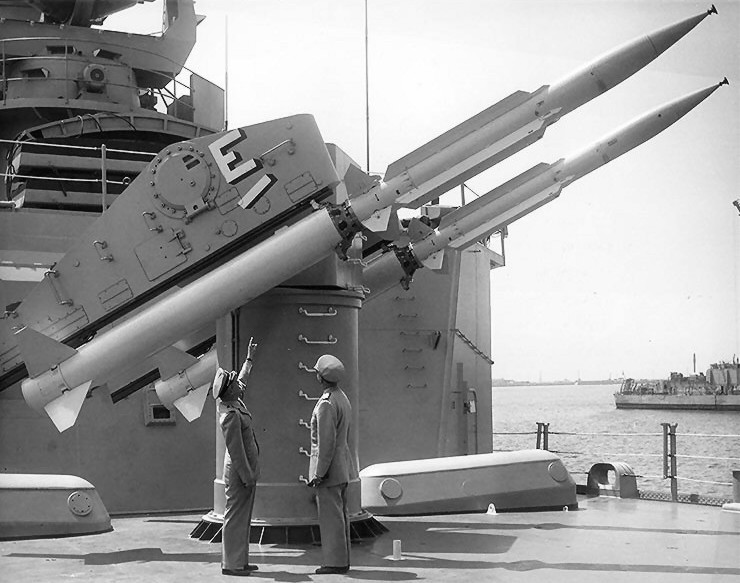
The RIM-66 Terrier is a family of medium-range surface-to-air missiles (SAM) developed by the United States for use by the U.S. Navy. The Terrier missile system was designed to provide naval ships with an effective defense against aerial threats, including enemy aircraft and anti-ship missiles. The development of the Terrier missile system began in the 1940s, and the missile was first deployed in the late 1950s. It was initially designed as a medium-range anti-aircraft missile to be used on naval vessels. It is a Two-Stage Missile: The RIM-66 Terrier is a two-stage missile system. The first stage is a booster rocket that propels the missile off the launch rail and into the air. After the booster separates, the second stage takes over and carries the missile toward its target. Guidance System: The Terrier missile system typically used semi-active radar homing for guidance. This means that the missile homes in on the reflected radar signals from the target, with the ship’s radar illuminating the target during the missile’s flight.
Variants: There are several variants of the RIM-66 Terrier, including the RIM-66A, RIM-66B, and RIM-66C. The different variants have improvements in terms of range, speed, and guidance systems.
Replacement: The RIM-66 Terrier has been largely replaced by more modern missile systems in the U.S. Navy, such as the RIM-67 Standard and RIM-156 SM-2 Standard missiles. These newer systems offer improved capabilities and better performance.
⚙ RIM-2 Terrier |
|
| Launcher | Twin-arm, 280° traverse and 60° elevation |
| Weight | 1,180 lb (540 kg), booster 1,820 lb (830 kg), total 3,000 lb (1,400 kg) |
| Size | 27 ft (8.2 m) x 13.5 in (34 cm) |
| Warhead | 218 lb (99 kg) frag/1kT W45 nuclear |
| Engine | Solid propellant rocket motor |
| Speed | Mach 3 |
| Range | 17.3 nmi (32.0 km) |
| Ceiling | 80,000 ft (24,000 m) |
| Guidance | Beam-riding |
SM-1ER Standard missiles:
The SM-1ER (Standard Missile-1 Extended Range) is an extended-range version of the RIM-66 Standard missile family. Like the original Standard Missile (SM-1), the SM-1ER is designed for use as a surface-to-air missile for shipborne air defense. The SM-1ER was developed as an improvement to the earlier SM-1 missile to enhance its range and overall performance.
It was primarily designed for use by the United States Navy to defend against aircraft and anti-ship missiles. The SM-1ER offers extended range compared to its predecessor, the SM-1. This increased range allows it to engage targets at a greater distance from the launching ship.
It is a Two-Stage Missile, Similar to the original Standard Missile, the SM-1ER is a two-stage missile system. The first stage provides initial thrust, and the second stage continues to propel the missile toward its target. It uses semi-active radar homing for guidance. This means that the missile homes in on radar signals reflected from the target, with the ship’s radar providing illumination. The SM-1ER has been succeeded by more advanced versions such as the RIM-66 Standard Missile-2 (SM-2) and variants.
⚙ SM-1ER Standard |
|
| Size | 26.2 ft (8.0 m) |
| Size Block II | 21 ft 6 in (6.55 m) with booster |
| Main body | 13.5 in (34.3 cm), booster 21 in (53.3 cm) |
| Wingspan | 5 ft 2 in (1.57 m) |
| Wingspan Block II-IV | 3 ft 6 in (1.07 m) |
| Weight | 2,980 lb (1,350 kg) |
| Weight Block II-IV | 3,225 lb (1,463 kg) |
| Warhead | Radar proximity and contact fuse, HE 137 lb (62 kg) continuous rod |
| Warhead Block II-IV | Radar proximity and contact fuse, HE Blast FRAG |
| Engine | Two-stage, solid-fuel rocket; sustainer motor and booster motor |
| Speed | Mach 3.5 |
| Range | 65–100 nmi (120–185 km) |
| Range Block II-IV | 100–200 nmi (190–370 km) |
| Ceiling | 80,200 ft (24,400 m) |
| Guidance | Inertial/SARH |
RUR-5 ASROC Antisubmarine Missiles
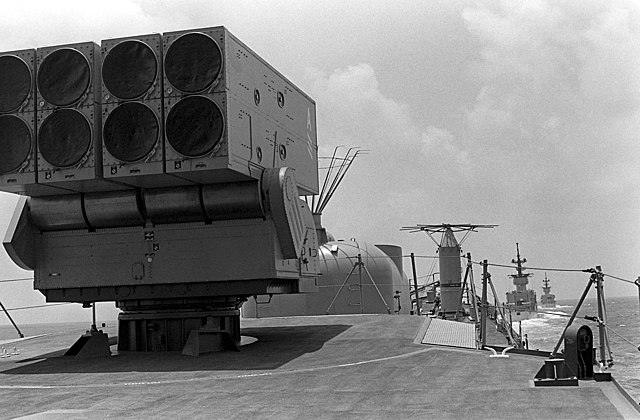
20 missiles carried internally, same launcher as the SAM. The RUR-5 ASROC (Anti-Submarine ROCket) is a family of missiles designed for the primary purpose of attacking and destroying submarines. It is a ship-launched missile system that was developed by the United States Navy and has been used by various navies around the world. The ASROC system was developed in the late 1950s and entered service in the early 1960s. It was created to provide a long-range anti-submarine warfare (ASW) capability for naval surface vessels. It is launched from surface ships, including destroyers and frigates, early versions being launched for a traversing/elevating armoured box launcher with eight canisters. Later it was launched vertically from a specially designed launcher, here the Mark 10 M7 twin arm. Payload includes depth charges, torpedoes, or nuclear depth charges. It uses inertial guidance system to reach the vicinity of the target area. Upon reaching the target area, the missile’s guidance is then taken over by an onboard guidance and control system to home in on the detected submarine using sonar.
⚙ RUR-5A Missile |
|
| Container | Internal storage, conveyor belt, vertical reload Mk10 twin arm launcher |
| Missile Weight/size | 1,073 pounds (487 kg), 14.75 ft (4.50 m) x 16.6 inches (420 mm), wspan 26+7⁄8 inches (680 mm) |
| Warhead | Mark 46 Torpedo, HE or 10 kt (42 TJ) W44 nuclear |
| Engine | Solid propellant rocket motor |
| Speed | Subsonic |
| Range | 6 mi (9.7 km) |
| Guidance | Vectoring, beam-riding |
5-Inch/54 Mark 42 gun
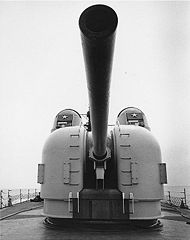 This guns constitutes a novelty compared to the Leahy class, which were “pure” missile cruisers, and a benefit from the Mark 10 univeral launcher, mixing ASROC-Terrier. The space available enabled the installation of the universal 5-Inch/54 Mark 42 gun, 127 mm, enabling dual purpose fire on air targets in the inner bubble (past the SAM range), surface warfare and anti-missile awarfare to some extent (after later upgrades) as well as shore bombardment, which explains why the Belnkaps were much more active in Vietnam than the Leahy.
This guns constitutes a novelty compared to the Leahy class, which were “pure” missile cruisers, and a benefit from the Mark 10 univeral launcher, mixing ASROC-Terrier. The space available enabled the installation of the universal 5-Inch/54 Mark 42 gun, 127 mm, enabling dual purpose fire on air targets in the inner bubble (past the SAM range), surface warfare and anti-missile awarfare to some extent (after later upgrades) as well as shore bombardment, which explains why the Belnkaps were much more active in Vietnam than the Leahy.
The 5″/54 caliber Mark 42 gun designation indicates that the gun has a bore diameter of 5 inches, and the barrel length is 54 times the bore diameter. In this case, the barrel is 270 inches (5 x 54). It is fully automatic, dual-purpose, with high rate of fire. It is capable of sustained rates of around 40 rounds per minute. It is designed to fire various types of ammunition, including high-explosive rounds for surface targets and proximity-fused rounds for anti-aircraft engagements.
The gun turret existed in single mounts or dual mounts here, single, with an effective range varies depending on the type of ammunition used and the target.
⚙ 5-Inch/54 Mark 42 gun |
|
| Turret size | 9.652 m (31 ft 8.0 in) |
| Turret Weight | 60.4 long tons (61.4 t) |
| Barrel | 6.858 m (270.0 in, rifling 5.82 m (229 in) |
| Recoil | 18.75 inches (476.2 mm) |
| Elevation/Traverse | -15°/+85°, rate 25°/sec – 150° from either side centerline, rate 40°/sec |
| Shell | 127 x 835mm .R 31.75 kg (70.0 lb) |
| Muzzle velocity | 2,650 ft/s (807.7 m/s) |
| Rate of fire | 40 rpm automatic original down to 28 rpm 1968 |
| Range (surface) | 25,909 yd (23,691.2 m) at +45° elevation |
| Ceiling (AA) | 51,600 ft (15,727.7 m) at +85° elevation |
| Guidance | Mark 68 gun fire control system with AN/SPG-53 radar |
3-in/50 Mark 34 AA guns (1970s)

Located on either side of the superstructure aft, close to the superfiring rear FCS, and after the service boats davits, they were installed on the deck.
⚙ 3-in/50 Mark 33 specifications |
|
| Shell | 12.13 in (30.8 cm) 24 lbs. (10.9 kg) |
| Elevation/Traverse | -15°/+85° at 30°/sec and 360° at 24°/sec |
| Muzzle Velocity | 2,700 fps (823 mps) |
| Antiship Range | (45°): 14,600 yards (13,350 m) |
| Rate of Fire | 40 rpm automatic (28 in 1968) |
| Ceiling | (85°): 30,400 feet (9,266 m) |
| Crew | 9 |
20mm/76 Mk 15 Phalanx CIWS (1980s)
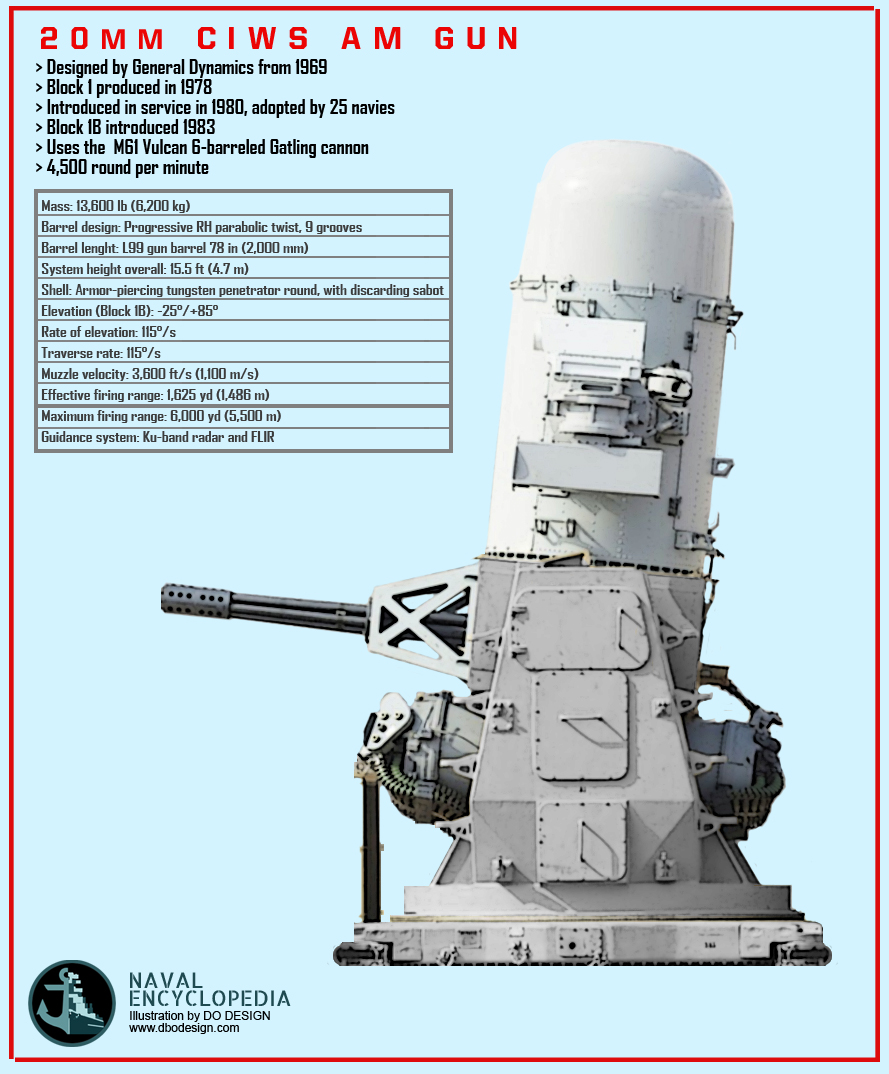
Standard short range anti-missile system, doubling as AA system. On the Belknap class, installed on either broadside on the structure.
Harpoon missile launchers
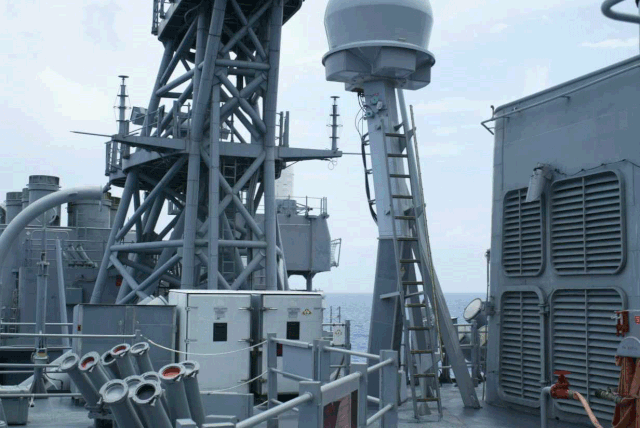
As a complement in medium range, in two quadruple launchers RGM-84A located amidships. The launchers were lightly armoured and hosted four individual missile tubes each. They were oriented to port and starboard at 90° and angled at 45°. Developed from 1977 by McDonnell Douglas and Boeing.
⚙ RGM-48 Harpoon |
|
| Container | 4-canister launchers |
| Weight | 1,523 lb (691 kg) including boostern |
| Size | 15 ft (4.6 m) long, 13.5 in (34 cm) diameter, 3 ft (0.91 m) wingspan |
| Warhead | 488 pounds (221 kg) utility warhead, impact fuze |
| Engine | Teledyne CAE J402 turbojet/solid propellant booster (600 lbf/2,700 N thrust) |
| Speed | 537 mph (864 km/h; 240 m/s or Mach 0.71) |
| Range | 75 nmi (139 km) range |
| Course | Sea-skimming, anti-jamming devices |
| Guidance | Radar altimeter and with active radar terminal homing |
Mk 48 Torpedo Tubes
 These were two 21″ transom torpedo tubes mounted port and starboard, removed in the NTU upgrade. Developed by the REsearch TORpedo Concept II (RETORC II) in the 1950s, in sevrice
These were two 21″ transom torpedo tubes mounted port and starboard, removed in the NTU upgrade. Developed by the REsearch TORpedo Concept II (RETORC II) in the 1950s, in sevrice
Photo: The Mk 48 was mostly used on submarines but also a few surface ships in ASW role. Twin Mk 25 tubes for Mk 48 torpedoes were fitted also in guided missile frigates (DLG/DLGN) in their stern counters. This photo shows a Mk 48 being launched from the USS Talbot (DEG-4). Lockheed Shipbuilding; US Navy.
⚙ Mark 48 acoustic torpedo |
|
| Powerplant | 2-speed, reciprocating external combustion (Otto fuel II) |
| Weight and size | 3,434 lb (1,558 kg), 19 ft (5.8 m) x 21 in (530 mm) |
| Warhead | 647 lb (293 kg), High explosive plus unused fuel |
| Propulsion | swash-plate piston engine; pump jet Otto fuel II |
| Speed | Max 55 knots, greater than 28 knots |
| Range | 38 km (24 mi; 21 nmi)/55 kn or 50 km (31 mi; 27 nmi)/40 kn |
| Exploder | Proximity fuze |
| Guidance | Common Broadband Advanced Sonar System |
| Max depth | 500 fathoms, 800 m (2,600 ft) estimated |
324mm Mk 32 ASWTT
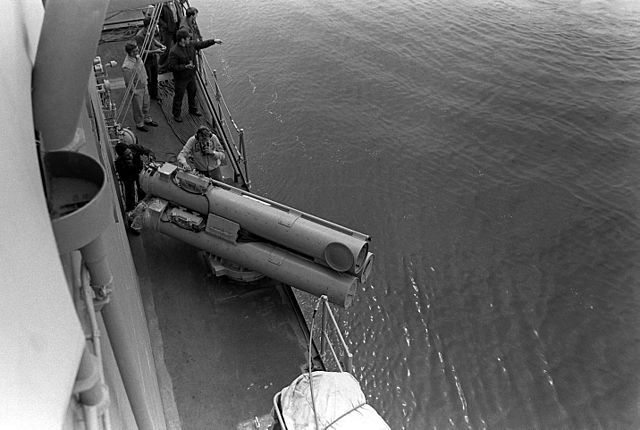
Two triple Mk-46 banks of 323 mm or 12.75″ torpedoes. In storage, 18 Mk 46 torpedoes.
The standard light triple ASW torpedo tubes banks, complementary to ASROC for short range but using the same acoustic Mark 46 Torpedo. They were located on the sides and rear of the of the forward superstructure on deck, close to the barriers that had a gap at this point. The rear superstructure had recesses to allow a full 360° traverse of the mounts. The bank can be pointed by an operator with electric drive and manual backup and torpedo reload was manual. Note, the Mark 46 was just introduced (1967) as these cruisers were completed. They were probably equipped prior with the Mark 44.
⚙ Mark 46 mod 0 acoustic torpedo |
|
| Powerplant | 2-speed, reciprocating external combustion (Otto fuel II) |
| Weight and size | 508 lb (230 kg), 8 ft 6 in (2.59 m) x 12.75 in (324 mm) |
| Warhead | PBXN-103 HE HBX-3 96.8 lb (43.9 kg) |
| Speed | 40 kn (74 km/h; 46 mph) |
| Range | 12,000 yd (11,000 m) |
| Exploder | Mk 19 type Mod 12 contact exploder |
| Guidance | Active/passive, homing (Helix/snake search) 123m to 3.4 miles (5.5 km) |
| Max depth | 1,200 ft (370 m)) |
Sensors
AN/SPS-10 surface search RADAR
Raytheon Technologies. Main cold war surface-search radar, variants AN/SPS-10B, AN-SPS/10E, and AN/SPS-10F. Service 1959.
Specs: 280 kW 2D, C Band PRF 650 Hz, Beamwidth 1.9° × 16°, Pulsewidth 1.3 µs
AN/SPS-48 3D air search radar
Air search three-dimensional radar from ITT Exelis, service 1960s, primary air search sensor. Used to guide RIM-116 SAM missiles.
Specs: 35 kW (avg) 17 ft (5.2 m) by 17 ft 6 in (5.33 m) radar. Work on E and F band (2 to 4 GHz) Range 250 nmi (460 km), alt. 100,000 ft (30,000 m)
Azimuth 0-360°, elevation 0-65° 690 ft (210 m) precision, 1/6° azimuth.
AN/SPS-49 2D air search radar
Raytheon 24 ft (7.3 m) × 14 ft 3 in (7.3 m × 4.3 m) 2D radar developed in 1975, using L band 851–942 MHz for a range of 3 nmi (5.6 km) to 256 nmi (474 km) (AN/SPS-49A(V) and up to 150,000 ft in altitude (45,720 m). Precisionw was 1/16 nmi range at 0.5 deg azimuth, Power 360 kW peak and 13 kW average.
Later SPS-48E radar, SPS-10F radar; + SPS-67(v)1 radar, LN-66 radar and SPS-64(v)9 radars were installed (1980s)
2x AN/SPG-55 Terrier missile fire control radar
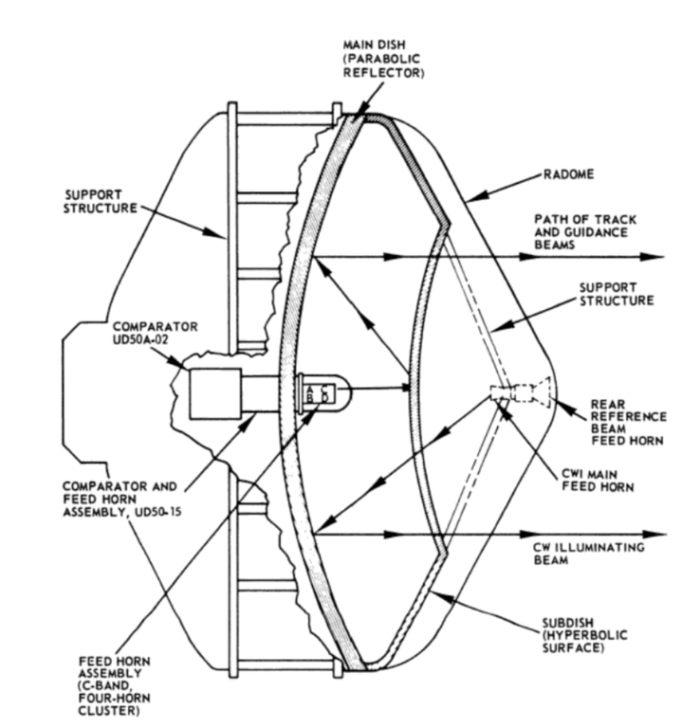
The AN/SPG-55 is a dish style tracking and illumination radar for the Terrier and RIM-67 Standard missiles coupled with the Mk 76 missile fire control system, controlled by a UNIVAC 1218 computer.
Specs: Frequency C-band Tracking and X-band Illuminator, PRF 427 Hz, Range 300,000 yd (150 nmi), 3D data.
About vietnam service: the battle of Dong Hoin on navweaps.com
AN/SQS-26 AXR or 26BX SONAR
The original AX sonars were manufactured by General Electric Heavy Military Electronics with the “R” suffix meaning “Retrofit” by GE, an improved designs derived from the AN/SQS-26CX sonar. Installed on the Bronstein, Garcia and Brooke-class frigates outside the Belknap.
Specs: 27 tons, 240 kW max, range 64 km (40 mi). Operating frequency: 3 kHz, Peak frequency: 192 kHz, Array height: 1.6 m (5’2″), Array diameter: 4.8 m (15’7″)
EW suite
The ships had the same electronics suite, only DLG28-34 different by having the NTDS CCS installed.
This comprise the WLR-1, WLR-3 ECM suites and two Mk 28 decoy rocket launchers.
After refit, four Mk 36 SRBOC decoy RL were fitted.
SRBOC Mk36 decoy RL:
Decoy rocket launchers launching radar or infrared decoys to interfere with the incoming missiles final guidance systems. The basic Mark 137 launcher has six fixed 130 mm mortar tubes arranged in two parallel rows. With four systems, each side could be covered by 24 chaff explosion, enough for saturation attacks.
Further refits:
SLQ-32(v)3 ECM suite installed.
It had antennas with electronic attack capability to actively jam targeting radars and anti-ship missile terminal guidance radars.
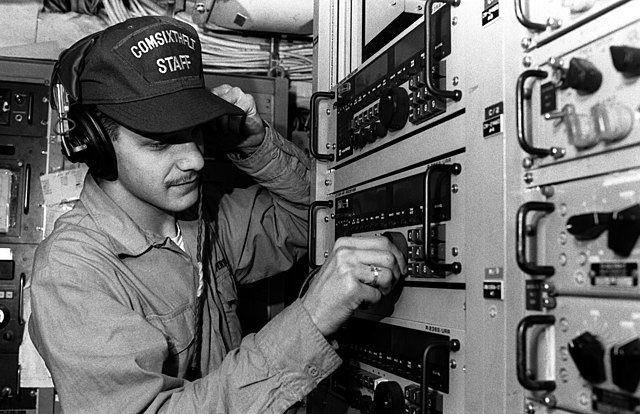
Radioman Joseph Pensado tuning his set aboard USS Belknap
Air Group
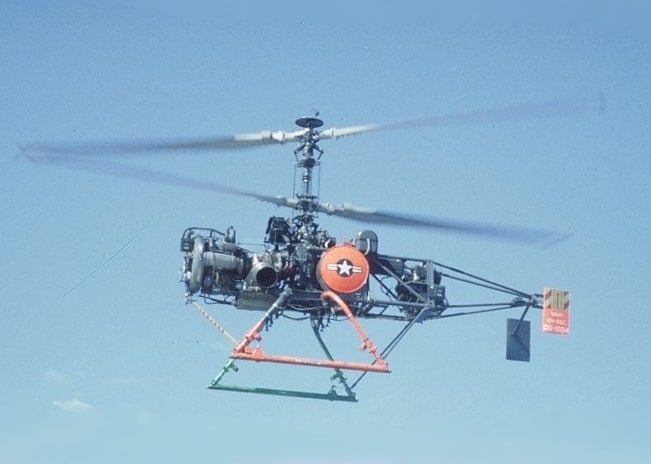
Initially these ships operated a DASH drone ASW helicopter, which was small enough for 2-3 to fit inside the hangar aft.
The Gyrodyne QH-50C DASH was an unmanned anti-submarine helicopter, remotelly controlled able to operate two Mark 44 homing ASW torpedoes over 22 nmi (41 km; 25 mi) around the ship. But it was completely unreliable with 50% of 746 drones lost at sea. Much had been said on these early drones, which had an appealing record of losses, accidents or malfunctions. This was 1960s technology after all. In the 1970s, most of the ships got rid of their Drone.
⚙ Gyrodyne QH-50C |
|
| Size | 12 ft 11 in (3.94 m) x 9 ft 8.5 in (2.96 m), rotor 2× 20 ft 0 in (6.10 m) |
| Weight | 1,154 lb (523 kg) max TO 2,285 lb (1,036 kg) |
| Powerplant | Boeing T50-BO-8A turboshaft, 300 shp (220 kW) |
| Speed | 80 kn (92 mph, 148 km/h), cruise 43 kn (50 mph, 80 km/h) |
| Ceiling | 16,400 ft (5,000 m), 1,880 ft/min (9.6 m/s) |
| Range | 35 US gal (29 imp gal; 130 L), 1h, 71 nmi (82 mi, 132 km) |
| Payload | 2x Standard Mark 46 ASW homing torpedoes or single Mark 44. |
| Guidance | Remote, from ship operator by multi-channel analog FM |
Helicopter: SH-2 Seasprite

The SH-2H Seasprite came as a replacement, which necessitated extensive modifications of the hangar.
The Kaman SH-2 Seasprite was for decades the main ASW and SAR helicopter onboard most ships of the USN. The prototype first flew in 1959, and it was adopted from 1966, the SH-2D/F LAMPS I version being the first deployed from december 1971. Later the 2F was developed. Full post on Plane Enyclopedia.
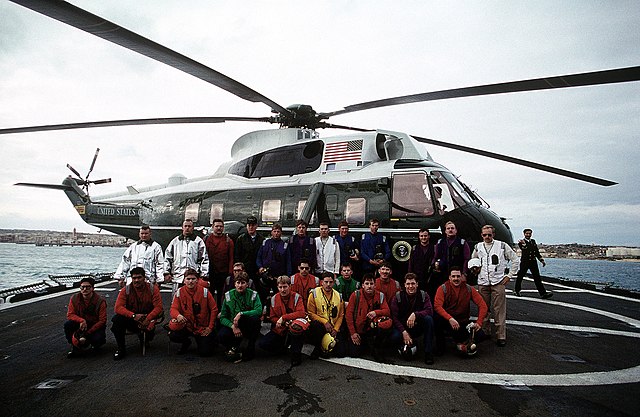
In 1988 during the Reagan-Gorbatchev Sicily conference, Marine Helicopter Squadron One (presidential hlicopter) HMX-1 and crew pose in front of their VH-3D Sea King aboard USS Belknap. By that time her Seasprite was removed as well as the hangar and original landing pad, relocated aft.
Modernizations
In the late 1960s, already USS Belknap and Josephus Daniels were retrofitted with the NTDS CCS installed on later ships.
1970s modernizations
All ships saw the removal of their two 533 mm TT banks and addition of the LN-66 radar
Later in the 1970s, USS Belknap, Josephus Daniels and Wainwright (in the 1980s this was for USS Jouett and Horne) came the swap of the Terrier/ASROC for the Standard SM-1MR SAM combined still with the ASROC ASuR (40 RIM-66, 20 RUR-5). Also were added two 76mm/50 AA guns for quite long time (removed for some in the 1990s). As well as two quad Harpoon SSM canisters amidships (8 RGM-84). The electronic suite followed with the removal of the SPS-43 and SPS-48 radars. They were replaced by the SPS-48C and SPS-49(v)3 radars. Also added were four Mk 36 SRBOC decoy RL.
Only difference for USS William H. Standley and Fox (and later for USS Sterett and Biddle) was their more advanced SPS-40 radar instead of the SPS-49.
Last addition was for the early ships, USS Belknap, Jouett and Biddle (later Josephus Daniels, Wainwright, Horne, Sterett, William H. Standley, Fox): The addition of a pair of two 6-barreled 20mm/76 Mk 15 Vulcan Phalanx, assisted by two Mk 90 radars. Also their DASH drone was replaced by the 1 SH-2D Sea Sprite ASW helicopter.
1980s modernizations
On all ships, the RIM-66 were replaced by RIM-67 Standard missiles. Later in the 1980s, the NTU program which for some ships ended in the early 1990s saw the last evolution, the SM-2ER Block II. Remaining 3-inch guns were replaced with two 4-cell Harpoon missile launchers, and all ships not fitted with two Phalanx CIWS had them installed.
USS Belknap saw the removal of her SQS-26BX sonar, exchanged for the SQS-53A sonar during her refit as flagship. USS Josephus Daniels instead had the SQS-26AXR sonar.
All ships also received the WLR-1 and WLR-3 ECM suites, and for those not equipped yet, two Mk 28 decoy RL. Later in the 1980s of early 1990s they also were fitted wot four single 12.7mm/90 (cal.50 ‘Ma Deuce’) to deal with asymetric threats. New electronic warfare systems were installed, the SLQ-32(v)3 ECM suite as well as the former Mark 28 replaced by four Mk 36 SRBOC decoy RL.
In 1983-1985 USS Belknap, Wainwright, Horne and Sterett received the TFCC CCS insteads of NTDS. USS Belknap being modified as flagship, she lost her SH-2D Sea Sprite helicopter, deck and hangar and accomodations built instead.
By the late eighties they lost their SPS-10F radar for the addition of the SPS-67(v)1 radar and the new SLQ-25 Nixie torpedo decoy system. In 1987 USS Biddle and in 1989, USS Horne, Jouett (the rest in the 1990s) received the new Standard missile and associated SPS-48E radar and for some, the SPS-64(v)9 radar.
Final configuration:
-SM-2ER Standard: One Mk 10 Mod 7 Guided Missile Launcher (40 missiles)
-RUR-5 ASROC Antisubmarine Missiles, same launcher (20 missiles)
-2×4 Harpoon missile launchers in armoured canisters (new)
-2×3 Mark 46 torpedo launchers (same as before)
-1× 5-Inch/54-caliber Mk. 42 gun (same)
-2× Phalanx CIWS (new)


Leahy and Belknap class illustrations by the author for comparison
⚙ specifications |
|
| Displacement | 5,400t standard, 7,890/7,930t FL (8,057 metric tons) |
| Dimensions | 166.8 x 16.7 x 5.5 m (547 ft x 55 ft x 29 ft) |
| Propulsion | 2 shafts HP turbines, 4 Babcock boilers 85,000 hp. |
| Speed | 32 knots |
| Range | 7100 nm |
| Armament | 1×2 MMA Terrier SMA-2 / ASROC ASM (60), 1×127 mm DP, 2×76 mm, 2×3 TLT ASM 324 mm |
| Sensors | SPS-43, 48, 2 SPG-55, Sonar SQS-26, NTDS radars. |
| Crew | 388 (max as flagship 27 officers, 450 enlisted) |
The tenth nuclear sister: USS Truxtun (CGN-35)
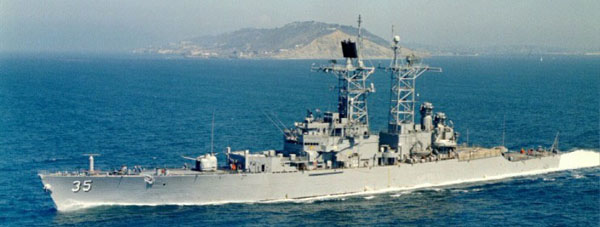
Just like for the Leahy class and USS Bainbridge, the Belknap had a derivative, the USS Truxtun, which shared the exact weapons suite, but stretched with a new section fitted with a nuclear reactor. This obliged detailed modifications like some weapons systems relocated and internal changes. Many information remains classified, and Truxtun seems closer to USS Belknap compared to Bainbridge for the Leahys.
USS Truxtun was commissioned in 27 May 1967, and significantly larger than USS Bainbridge as well, displacing 7,930 tons standard for 167 m long (547 ft) overall, more beam than the Belknaps at
55 ft or 17 m and more draught as well at 29 ft or 8.8 m. Outside the reactor, this was the same powerplant and top speed (officially) but unlimited range. The crew was comparable as the weapons suite was the same. She followed also the same modernization pattern as the Belknap class in the 1980s.
USS Truxtun served in the Pacific and saw action in Vietnam, being awarded seven battle stars and a Navy Unit Commendation. She was decommissioned in 1995.
She will have a dedicated article.

Profile, Conways
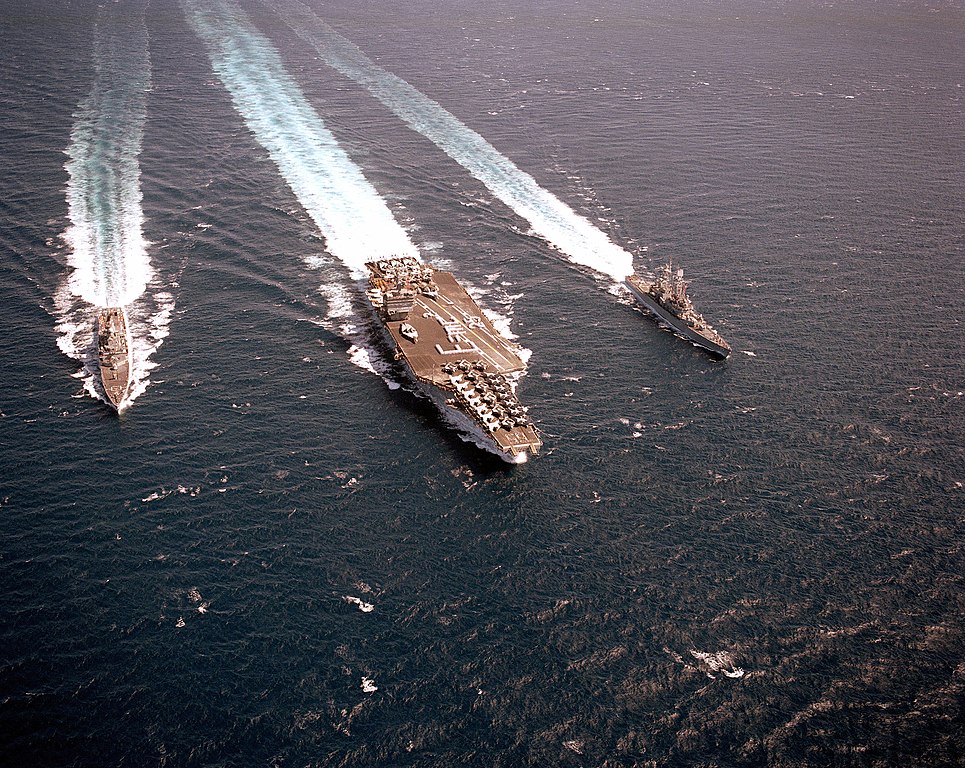
USS Truxtun escorting USS Enterprise and the nuclear-powered cruiser USS Arkansas in the Pacific, 17 September 1986.
Career of the Belknaps
These ships also embarked for a while ASM helicopter drones (DASH), and four TTs special ASM mk48 at the stern. They were also permanently equipped with the NTDS (Tactical Naval Data Integration System). These ships knew their baptism of the fire with the viet-nâm: Thus on April 19, 1972 the USS Sterret destroyed a large North-Vietnamese anti-ship missile Styx with the help of one of its Terrier (a world first), and downed two Migs during a combined air/surface attack, demonstrating the effectiveness of NTDS. On 19 July, USS Biddle dispersed a formation of Migs attacked at night, destroying two. They were later modernized, USS Wainwright testing the new SM2 ER, USS Fox testing Tomahawks in 1977, and from 1981 all received two quadruple ramps of Harpoons. On this occasion, they also received SPS48 and 49 radars. They were all active in the 1990s, but removed from service in 1993-95, all scrapped since, none preserved.
 Belknap DLG-26
Belknap DLG-26
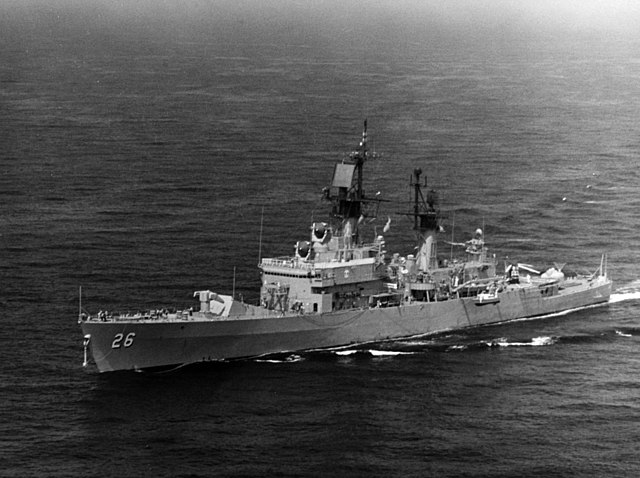
Belknap in 1973
USS Belknap was laid down at Bath Iron Works Corporation (Maine) on 5 February 1962, launched in 1963 as DLG-26 (guided missile frigate) to be later reclassified as CG-26 on 30 June 1975. Commissioned on 7 November 1964 her records are not yet published from 1965 to 1975 (to be updated). She served with the 6rh fleet in the Mediterranean and Atlantic 1st fleet.
The major even of her career was when she was severely damaged in a major collision with the aircraft carrier USS John F. Kennedy on 22 November 1975, off the coast of Sicily. Her superstructure was literraly razed (see photo) and a fire broke out, her aluminum superstructure collapsing after heat ing up and seven sailors were killed.
Other vessels came for assistance and pull the carrier out of Belknap to avoid fire spreading. The guided missile destroyer USS Claude V. Ricketts and Bordelon took positions on both sides of Belknap and used their fire hoses to the amidship section ablaze, despite safety risks for themselves. USS Bordelon ironically was also badly damaged after a collision with USS Kennedy in 1976 and the damage was so great she was decommissioned. USS Claude V. Ricketts moved evacuated injured personal, mostly from falling fragments as ammunition lockers exploded on the weather decks. The frigate USS Pharris meanwhile assisted the carrier. Live Ammunition on Belknap consisted mainly of 3-in rounds amidships, and they quickly cooked off, but did not scared off the rescuers, which led after the even to many awards for gallantry.
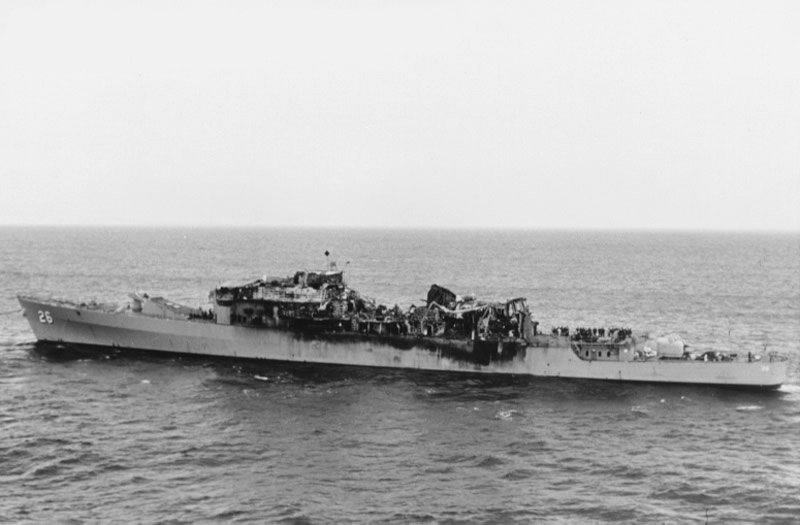
The ammunition ship Mount USS Baker also took part in the rescue and salvage as she evacuated her ammunitions remaining and provided electric and water supplies, her Explosive Ordnance Disposal team retrieving the most sensible remaining ammunition. She also hosted USS Belknap’s crew. This fierce fire was important as it changed the USN perception of materials used for superstructures.
They would argue that if made of steel, damage would have been not so great. It was decided to return to all-steel construction, although a NY Time article in 1987 also pointed out the craking structure on Oliver Hazard Perry-class frigates as another reason.
All steel superstructure construction was enforced on the the Arleigh Burke class, with also a lot of composites internally, as they were commissioned in the 1990s. USS Belknap was a bit too young in 1975 to be decommissioned and she was reconstructed at the Philadelphia Navy Yard (30 January 1976 to 10 May 1980). The hull was in good condition and the Navy used her as test platform for the Aegis system. So after her almost fatal collision, ironically, USS Belknap became the powerful warship in the world, and prototype for the Ticonderoga class.
She resumed service with the 6th fleet and was off Beirut in the multinational peacekeeping force, the first to fire on Iranian-backed militias positions. Her Naval Tactical Data Systems (NTDS)was seriously tested during this, and she became the default 6th Fleet flagship.
No records for 1981-85.
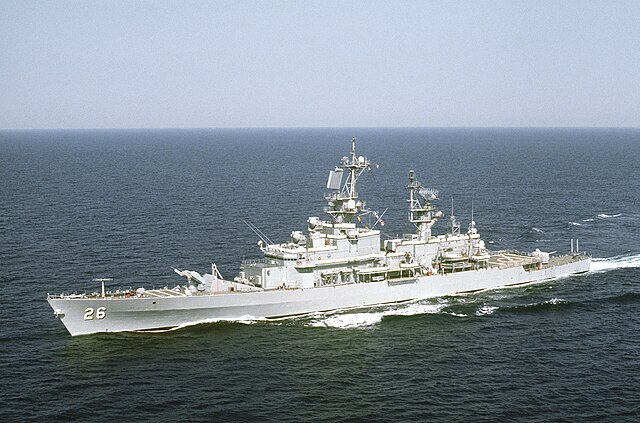
USS Belknap as rebuilt in 1992, Mediterranean
USS Belknap back home was further converted as flagship at Norfolk Naval Shipyard (May 1985-February 1986) with a modified superstructure aft of the missile launcher, three decks up for flagship pacilities and personal, and additional communication equipments with her helicopter hangar turned into extra accommodation spaces. She also had a small detachment of Marines. She was deployed to Italy, Gaeta naval base, back as 6th Fleet flagship, and relieving USS Coronado. On 27 May 1986 she paraded in Barcelona.
She hosted the Malta Summit, with U.S. President George H. W. Bush and Soviet Leader Mikhail Gorbachev, on 2-3 December 1989. The latter and his delegation slept aboard the cruiser Slava. Both were anchored on the roadstead off the coast of Marsaxlokk but the summit was plagued by Stormy weather, so much so the press titled the “Seasick Summit”. The final meetings were held on the cruise ship Maxsim Gorkiy in La Valletta, with a specially tailored, storm proof mooring arrangement.
After this, no precise record from 1990 to 1995. She was decommissioned and stricken on 15 February that, year, sunk as a target on 24 September 1998.
 Josephus Daniels DLG-27
Josephus Daniels DLG-27
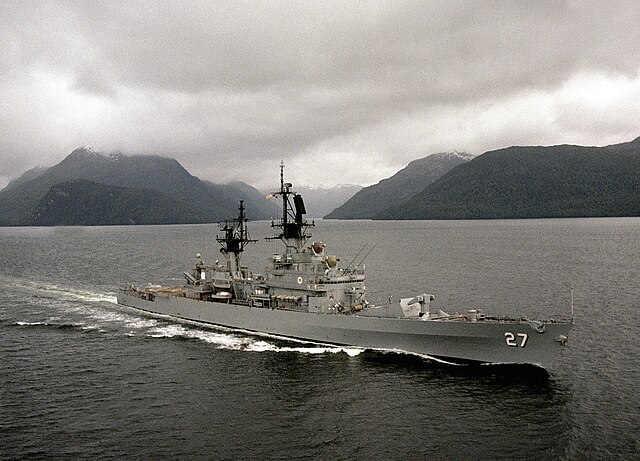
USS Josephus Daniels (DLG/CG-27) (named after Josephus Daniels, WWI Secretary of the Navy) launched as DLG-27, after the contract was awarded on 18 May 1961 to Bath Iron Works, laid down on 23 April 1962. She was commissioned on 8 May 1965. No records available (so far). She was decommissioned on 21 January 1994 after 28 years of career, stricken 21 January 1994 and mothballed in the James River Reserve Fleet near Fort Eustis in Virginia, waiting her turn to be scrapped, which was done in Brownsville, Texas until 8 November 1999. She was nicknamed ‘Joey D’.
 Wainwright DLG-28
Wainwright DLG-28
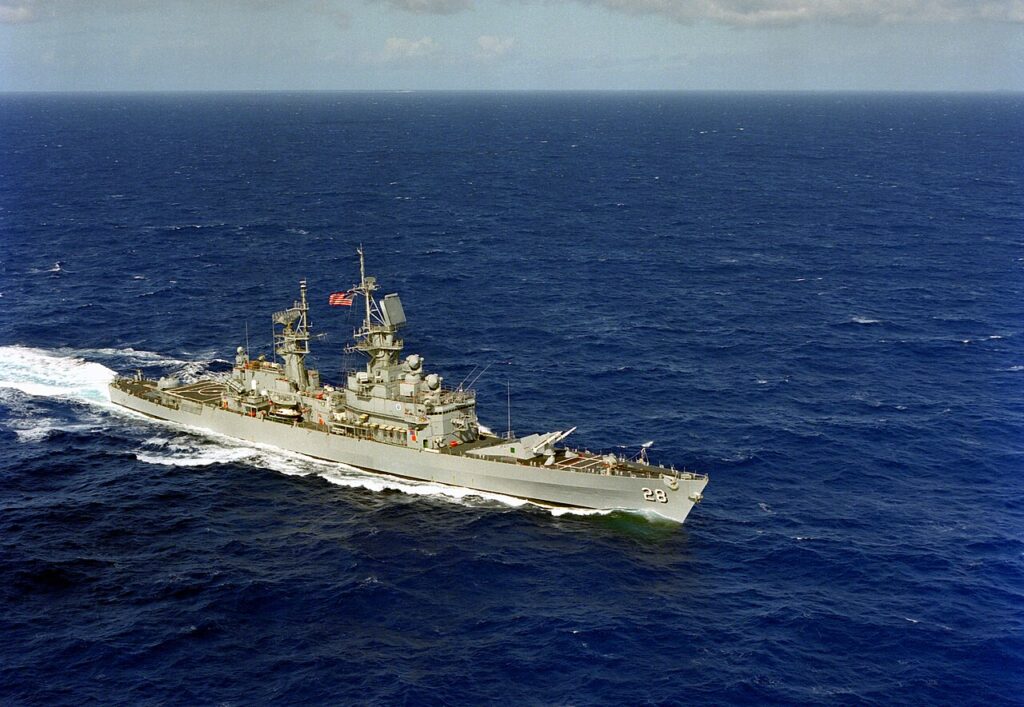
3rd of the name, named for members of the Wainwright family (Commander Jonathan Mayhew, son Master Jonathan Mayhew Jr., cousin, Cdr. Sr. and son RADM Richard Wainwright Jr. Rear Admiral Richard Wainwright, and his own son. A long lasting family tradition. The keel was laid down on 2 July 1962 at Bath, Maine, she was launched on 25 April 1965 (chistened by Mrs. Richard W. Wainwright), commissioned on 8 January 1966 at Boston Naval Shipyard for fitting out.
She made her shakeddown cruise to Cuba in January and May from Boston, testing her sonar and homeprted to Charleston in the summer, operating along the eastern seaboard from Newfoundland down to the West Indies. She made her weapons qualifications, including six highly successful missile firings at the weapon range plus ASW chase of an unknown submarine contact. This was the longest range sonar tracking at the time. 13 August saw her in upkeep for her long shakedown training from the 28th and new weapons tests at Culebra Island range and back. She was prepared and sailed for her first Atlantic Fleet exercise, 17 days of drills in September to December. She ended the year with crew leave and upkeep.
Vietnam Service (4 battle stars)
On 6 January 1967, she left Boston after her post-shakedown availability to Charleston on 15 March and after exercises was called to the western Pacific on 10 April. She was at San Diego by 23 April and after exercises sailed on 15 May for Pearl Harbor,d Guam, and Subic Bay on 3 June. On the 6th she was in the Tonkin Gulf and as air guard, tracking contacts. This was her first PIRAZ, relieving USS Long Beach. She secired the gulf, vectoring defenses and interception from the carriers. Static, she also became a reference point for pilots in strike missions underway and back. She also became a SAR base for search and rescue helicopters. One SAR helicopter crashed on her flight deck area but damage was light, albeit hte helicopter was toasted off.
After R&R and upkeep at Sasebo she was back to PIRAZ duty and assisted USS Forrestal during her fire in July 1967.
From 12 August she stayed 27 days on station, until 8 September, cleared the gulf for R&R in Hong Kong. On 15 September she was back in Vietnam and became screen commander for the two carriers at “Yankee Station”, southern Tonkin Gulf, and AA command ship for TF 77. On 28 September she left for home via Subic Bay, Sydney, Wellington, and Tahiti, transiting to Charleston via Panama.
In 1968, 19 January she lefy for Newport in Rhode Island as school ship for the Destroyer School until back on 5 February. She took part Operation “Rugby Match” in the West Indies and went back to another WestPack and Vietnam TOD on 24 June. She started operation from Subic Bay on 30 July. She was in Da Nang for briefings on 2 August, relieving USS Sterett on PIRAZ station and stayed for 41 days, only leaving to evade a typhoon. On 14 September, she exchanged duty to USS Sterett and made port visits (Hong Kong, Yokosuka) and back to PIRAZ station, relieving Sterett. She left the Tonkin Gulf on 15 November for upkeep in Sasebo and back on the 28th and later a third and final PIRAZ tour after a pause at Subic Bay 5-9 January 1969. Before leaving she stayed at Sydney, Auckland, Papeete, and after Panama stopped at St. Thomas and was in Charleston on 21 February.
After leave and upkeep, Wainwright she underwent many inspections. At Norfolk, she was part of the Presidential Seapower Demonstration in the Virginia Capes. Next she was at “Exotic Dancer” and later “Spark Plug” with NATO’s fleet from Canada, Great Britain, Netherlands, Portugal until 11 June 1970 and homeport to disembark Cruiser-Destroyer Flotilla 2 commander. On 18 August she started her first major overhaul.
From 16 February 1970, she trained off the Virginia Capes, gunnery and missile tests at the Atlantic Fleet weapons range, Puerto Rico, Refresher training off Cubad and special assignments, intercepting three Haitian Coast Guard vessels fleeing after an unsuccessful coup and on 10 May, to intercept and shadown a Soviet task group heading for Cienfuegos on 14 May. On 12 June, she was in upkeep at Charleston and after preparations left on 25 August for her third and last Vietnam TOD. She was in Yokosuka on 21 September and in exercises for two months, with the Japanese Maritime Self Defense Force. On 14 November she left for the Tonkin Gulf, relieving USS Jouett on PIRAZ station, relieved later by USS Chicago
She became the SAR coordinator ship for a month, north and south SAR stations interrupted by Operation “Beacon Tower”. On 16 December she left for Singapore, the Philippines spending the new year’s eve there. On 4 January 1971 she sailed for Hong Kong and back to Subic Bay after repairs to one radar antenna and back to Tonkin Gul for 16 days in PIRAZ/SAR, northern sector.
After a stop at Subic Bay she sailed back to Charleston this time via the long route, the Indian Ocean, Cape of Good Hope and across the southern Atlantic for her first circumnavigation, stopping in ports such as Djibouti, Massawa (Ethiopian Navy Day, visited by Emperor Haile Selassie I), Diego Suarez, Lourenço Marques, and Rio de Janeiro, Recife, St. Thomas and a stop at the Culebra range arriving on 2 April.
Atlantic Fleet Service
In June 1971 she took her place in the Atlantic Fleet Cruiser-Destroyer Force, with weapons exercizes in the Caribbean Sea, still base din Charleston. She was converted to operate a seasprite Light Airborne Multi-Purpose System (LAMPS). She was to have her propulsion plant burning Navy distillate fuel until January 1972. The year was spent between LAMPS tests, port visits and Second Fleet exercises. In December she left for Rota, Spain and the Sixth Fleet, where she made ASW and AAW exercises notably from Naples. On 6 January 1973 she headed for the Ionian Sea and tracked four Soviet submarines. She was in Marseille on 17 January, Palma de Mallorca, Málaga, Genoa. She trained with the cruiser Vittorio Veneto at National Week XV with the Greek and Turkish navies in the Strait of Messina between Sicily and southern italy.
Later she visited Athens, Civitavecchia, Livorno, Golfe Juan until reaching Palma de Mallorca and Rota relieved by USS Belknap on 21 June.
She was in another exercise off Lisbon with the LSD USS Guam and DD Bowen, used as sea control ship (new concept). She vectored Guam’s Harrier II in interception of two Soviet “Bear” aircraft. Later USS Wainwright crossed the Arctic Circle, and sailed to Charleston, arriving on 20 July and Charleston Naval Shipyard for another overhaul.
After sea trials until 14 June 1974 she was back with the Atlantic Fleet with cruised to the southern Atlantic coast and Caribbean. In 1975 she was drydocked at Norfolk Naval Shipyard, for sonar dome replacement and back to Charleston in February 1975. En route to the Mediterranean she joined USS Forrestal battlegroup for exercises and reached Spain, Rota on 17 March, then Naples on 22 March. Training exercises went on, interrupted by a Soviet destroyer sneaking in to observe her drills.
In June she crossed the Bosphorus and Dardanelles into the Black Sea (first American ship to visit Romania at Constanţa in 49 years). She was shadowed by the Soviet helicopter carrier Leningrad and learned on 30 June, her redesignation as guided missile cruiser CG-28. On 22 August she arrived at Rota on her way home. In 1946 she was in routine Second Fleet operations. On 30 June she was New York City for the International Naval Review and Operation “Sail” (Bicentennial) as flagship for the naval review and Operation, hosting the Vice President Nelson D. Rockefeller, Secretary of State Henry Kissinger, Secretary of Defense Donald Rumsfeld, Admiral James L. Holloway III, and CNO Admiral Shanahan, Second Fleet.
31 March 1977, saw her 3rd Med TOD via Rota on 12 April and June she returned in the Black Sea. She was back home on 21 October. She took part in “READEX 1-78” by February, southern Florida-Caribbean. Next she had a 13-month overhaul until March 1979. No record until 1988.
Operation Praying Mantis started on 18 April 1988, an action in retaliation for the Iranian mining of the frigate USS Samuel B. Roberts sailing in the Persian Gulf (Operation Earnest Will, 1987-88 convoy of Kuwaiti oil tankers); This signed the first surface-to-surface missile engagement of the USN at the time. USS Wainwright and two frigates attacked the Sirri oil platform and landed the USMC MAGTF 2-88 to gather intelligence and set explosives. She dealt with Boghammar speedboats and vectored an A-6E Intruder aircraft from VA-95, sinkling them with Rockeye II cluster bombs. She also ws signalled an Iranian Kaman-class INS Joshan (La Combattante II type) FAC, firing a Harpoon, while USS Wainwright sent four Standard missiles. USS Bagley fired also one Harpoon at Joshan and she was finished off by gunfire.
Then the Iranian frigate Sahand departed Bandar Abbas was shadowned by VA-95 A-6E Intruders and launched missiles at the latter and the launched two Harpoons and four laser-guided Skipper bombs plus Harpoons from USS Joseph Strauss which sank Sahand. Sablan was later repaired in 1989. Sole casualty on the US side was a Marine Corps AH-1T Sea Cobra gunship from USS Trenton, crashing 15 miles (24 km) SW of Abu Musa island. USS Vincennes later in high tensions shot down a commercial airliner 2 months after arrival.
Operation Praying Mantis as marked as decisive.
After this, USS Wainwright was decommissioned on 10 November 1993, mothballed for a decade and sunk as target on 11 June 2002 by two Harpoons from HMS Richmond, finished off HMS Tireless (Spearfish torpedo) loosing her bow, and bombed by US aircraft and finally scuttled with explosive charges after a landing party came in. Quite a remarkable survival.
 Jouett DLG-29
Jouett DLG-29
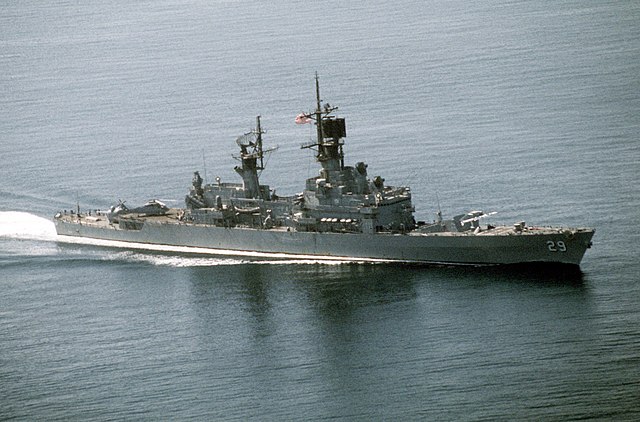
USS Jouett was laid down 25 September 1962 at Puget Sound Naval Shipyard in Bremerton, Washington, west coast, launched 30 June 1964, commissioned 3 December 1966. After fitting out in February 1967, she was assigned to Cruiser-Destroyer Force, U.S. Pacific Fleet, homeported to San Diego.
No record for her as now. She was decommissioned, stricken on 28 January 1994 at San Diego. Transferred 30 March to the Maritime Administration in Suisun Bay reserve. Towed from 10 August 2007 to be spent as target ship in Exercise Valiant Shield 2007. Her bell has been preserved at the Navy Entomology Center of Excellence Naval Air Station in Jacksonville, Florida.
 Horne DLG-30
Horne DLG-30
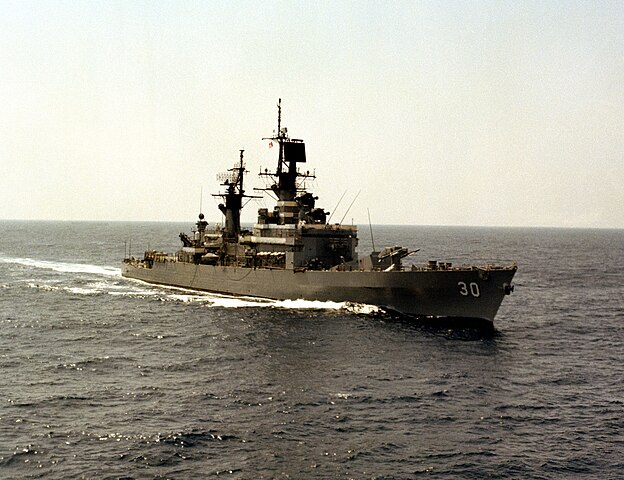
SS Horne (after Admiral Frederick J. Horne, 1880–1959) was contracted on 20 September 1961 to San Francisco Naval Shipyard laid down on 12 December 1962, launched 30 October 1964, completed on 7 July 1967 and commissioned on 15 April 1967 with the Pacific fleet. No records from 1968-1982 but she served in Vietnam according to her awards: Vietnam Service Medal, six stars and Southwest Asia Service Medal (1 star), Silver star, Bronze star and eight Sea Service Deployment Ribbons as well as the Republic of Vietnam Gallantry Cross.
She was logically deployed for PIRAZ for battle groups and SAR missions in the gulf of Tonkin in 1967-69.
On 20 July 1983 The New York Times reported that the cruiser, as part of the Ranger Battle Group left San Diego on Friday 15 July 1983 for the western Pacific and then Central America for training off the coasts of Nicaragua, El Salvador and Honduras. In addition of the Forrestal class USS Ranger and Horne, the fleet comprised the guided missile destroyer USS Lynde McCormick, destroyers Fletcher and Fife, frigate Marvin Shields, oiler Wichita, support ship Camden.
She took part also in Middle Eats operations, notably the gulf war.
After 26 years of service, she was decommissioned on 4 February 1994, struck also, placed under the US Maritime Administrationn laid up at Suisun Bay National Defense Reserve Fleet. She ended as target on 29 June 2008 (RIMPAC 2008).
 Sterett DLG-31
Sterett DLG-31
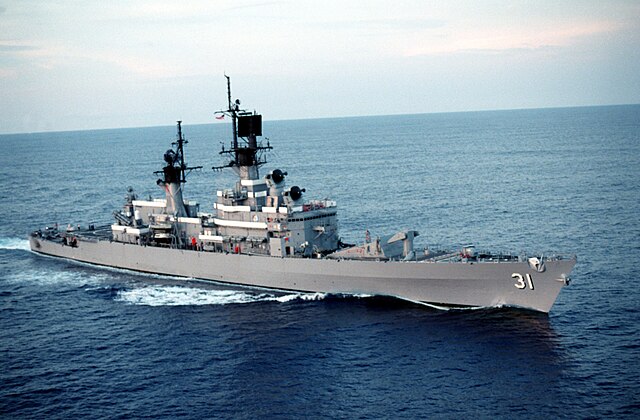
USS Sterett (DLG/CG-31) (3 named after Master Commandant Andrew Sterett (1778–1807)) saw her contract awarded on 20 September 1961 to Puget Sound Naval Shipyard, laid down on 25 September 1962, launched on 30 June 1964, completed on 16 June 1967, commissioned on 8 April 1968.
Vietnam Campaign 1967-73 (nine battle stars)
On 1967 she trained on the west, post-acceptance tests-trials, shakedown and fixes at Puget Sound. Later she made a nuclear capable certification and COMTUEX 8–68. In june she departed San Pedro Bay for a first Pacific deployment, via Pearl Harbor and Midway to Yokosuka, Japan and in July, the Tonkin Gulf.
On 31 July 1968 she relieved USS Horne at PIRAZ station escorted by destroyer USS Rich in North Vietnam, until relieved on 5 August and moved to SAR ship and strike support ship (SSS) until 4 September and alternated between these until mid-March 1969. She won the Green “E” for Operations and White “E” for Missiles, Red “E” for Engineering, Blue “E” for Supply, the whole package with Congratulations from CincPac.
Later she was in the Sea of Japan as PARPRO picket station working with the 314th Air Division interceptors from Osan AB. They intercepted six Soviet Tupolev Tu-16 and Beriev Be-12 on ASW patrol. She was relieved by USS Richmond K. Turner on 10 March, followed by a Petya-class frigate in the Korean Straits. Sterett joined TU 71.0.4 to the Gulf of Tonkin and helped a deriving north korean refugee boat.
April 1970 saw her in modified PIRAZ station closer from the North Vietnamese coast and escorted by USS Oklahoma City. She was to vecor interceptions or shot down migs from Bai Thuong Air Base (three MiG-21, three MiG-19). Oklahoma City had Talos missile which completed the Terrier “trap” but they made no kills. Sterrett went on between Yokosuka and the Gulf of Tonkin in 1970, with R&R in Hong Kong and Keelung, Taiwan. She was present at EXPO ’70 in Kobe before departing for home on 29 July 1971.
She spent 1971 either in port or the west coast.
On 7 January 1972 she departed for Vietnam, Gulf of Tonkin, PIRAZ and on 21 February 1972 she was the first to vector the CAP downing a MiG-21. She vectored planes for two more on 30 March and shot another with Terrier missiles off Dong Hoi, 19 April. She also fired Terriers at Styx missile underway, destroying them. She was at Subic Bay on 22 May and after four more months operations she headed for San Diego, for the remainder of 1972.
On 25 March 1973 during transit she lost a LAMPS helicopter but all crewmen survived.
After cease fire negotiations in 1973 she returned to shiow the flag and patrols and was back to San Diego and an overhaul from February 1974.
Pacific Service 1975-1995
In October 75 she was deployed in the Western Pacific, South China Sea, Gulf of Tonkin for 8-month and stopped in the Philippines, Singapore, Thailand, Hong Kong, Okinawa, Korea and Japan. This was concluded in 1976 and she spent this year until 1977 in San Diego. On March 1977 she had her HSL-33 helicopter installed and departed for Yokosuka but in 11 March 1977 she lost her Seasprite helicopter (crew rescued). She sailed to Iran for operations with the Imperial Iranian Navy. After local ops in the Indian Ocean she was back home in October 1977. She was in maintenance availability untilMarch 1978. By May-June 1978 she cruised with Midshipmen. In July she took part to the Portland Rose Festival and Seattle SeaFair celebration. In September 1978 she returned to the Western Pacific and Indian Ocean, then Gulf of Oman, coast of Iran during the Revolution until relieved on 14 January 1979.
In April she was back to San Diego and was modernized in the summer 1979 at Long Beach until October 1980. On 20 July 1983 Sterett rescued 264 Vietnamese boat people in the Gulf of Thailand.She searched for survivors or debris from the Korean Air Lines Flight 007 and became flagship of SAR Task Force 71 this winter.
In late 1985 she was in the North Pacific to shadow the new Kiev class Soviet aircraft carrier departing from Vladivostok. She later stand at Manila Harbor to evacuate as an option the presidential family (People Power Revolution). Her homeport was provisionally Subic Bay; By 1991 she had a new overhaul and NTU. She did not served in the Gulf War and stayed in the Philippines (notably during the pinatubo eruption) until 1992.
In 1993 she was deployed in a Central America/Caribbean Counternarcotics Operations.
After 27 years of service she was decommissioned on 24 March 1994, struck and sold to International Shipbreaking Limited of Brownsville on 29 July 2005 to be BU and recycled.
 William Standley DLG-32
William Standley DLG-32

Contract for USS William H. Standley was awarded on 16 January 1962 to Bath Iron Works, where she was laid down on 29 July 1963, Launched 19 December 1964, completed 28 June 1966, commissioned on 9 July.
After qualification trials she was in Boston an dmade her shakedown to Guantanamo Bay by January 1967. She became flagship for Rear Admiral E. R. Bonner CruDivFlot 6, present at the “Springboard” exercise in the Caribbean and she visited San Salvador and San Juan in Puerto Rico, the post-fixes in Boston in April. By 12 June 1967 she was at the Operational Test and Evaluation Force. Underway she stopped at the Canary Islands. She was homeported at Mayport on 14 July as flagship ComDes Ron 8.
She trained at the Atlantic Fleet Weapons Range, visited the Virgin Islands and lade her first Mediterranean deployment, sailing on 6 October 1967 to join the 6th fleet with USS Goodrich and USS Turner, TG 60.2 as flagship. She made numerous ports stopped and watched Soviet activity from the Back sea to the Mediterranean.
In 1968, William H. Standley took part to “Phiblex 10-68” with the French Navy, and became picket duty, eastern Mediterranean. She was back home on March 1968.
After upkeep she was a plane guard duty for USS Intrepid (CVS-11) and went on search for the mission USS Scorpion (SSN-589).
Vietnam War Campaign (4 battle stars)
Despite being an east coast ship by June after making a cruise with 40 midshipmen to Norfolk, in July 1968 she had an overhaul at Charleston in August and was modified for PIRAZ and operations in the Gulf of Tonkin. On 2 December she left to train at the Atlantic Fleet Weapons Range at Vieques, transited Panama and was in Hawaii in time for Christmas, proceeding in January 1969 to Subic Bay, and on 23 January the Gulf of Tonkin, relieving USS Mahan (DLG-11) until relieved herself on 25 February, by the same. She had upkeep and R&R in Sasebo, then trained at Subic Bay and was back in the gulf on 22 March just as tensions in Korea erupted. There were clashed on the DMZ on 11 March and 15 April when fighters downed a JMSDF EC-121 reconnaissance plane in the sea of Japan.
Standley stayed 50 days on the line in PIRAZ and SAR stations. She operated two helicopters simultaneously and was congratulated by Rear Admiral E. J. Rudd, before being relieved by USS King (DLG-10), having R&R in Hong Kong and back to Yokosuka on 28 May.
After upkeep she replaced USS Sterett (DLG-31) as southern SAR ship in June and in turn by USS Chicago (CG-11), sailing for Pearl Harbor in July 1969, Galápagos, Panama and Mayport on 20 July.
On 5 January 1971 she returned to Panama, Pearl Harbor, the Mariana Islands and Guam on 5 February 1970, Subic Bay saving the crew underway of the Philippine freighter Santa Anna and the Gulf of Tonkin for 25 days as escort of USS Ranger (CVA-61), northern SAR station. After a stop at Sasebo she was back as PIRAZ ship. On her way home she stopped at Sattahip, Singapore, Victoria in the Seychelles, Maputo, rounded the Cape of Good Hope and arrived at Rio de Janeiro, then NAS Roosevelt Roads in Puerto Rico and Mayport on 18 August 1971 concluding her first circumnavigation over 51,000 miles. She was in local waters in 1971, and earned 4 battle stars for her service.
Mediterranean service 1971-76
By January 1972, she took part in Operation “Snowy Beach” and trained at NWS Yorktown. From Mayport she took part in Atlantic Fleet exercises. In the Caribbean she became flagship for CruDesFlot 6 in the autumn. She had nect a major overhaul starting on 20 November 1973. In 1974 she was at the missile Atlantic Fleet Weapons Range and stopped later in Haiti. She cruised with naval reservists in March and took part in an ASW exercise against USS Trutta (SS-421) and LAMPS helicopter trials.
Next she made her second Mediterranean 6th Fleet TOD with TG 27.4, but loosing en route her SH-2D Seasprite. She reached Rota on 22 June and trained with USS Harry E. Yarnell (DLG-17) with TF 60, Operations “Good Friendship,” “Quick Draw,” “National Week,” “Bystander” stopping at Livorno, Cannes, Golfe-Juan, Palma de Mallorca, Athens, Corfu, Mersin and Izmir, Barcelona, Málaga, and back to Rota in Spain. On 9 December she sailed for Charleston. Until 17 January 1974 she had an overhaul.
She left Charleston on 14 June 1974 for a 3rd deployment, stopping at Saint-Tropez and Theoule (later Civitavecchia) for the anniversary of Anvil Dragoon. Until September she was present for the Greco-Turkish crisis over Cyprus. She was in Augusta Bay, Sicily and escorted USS Vreeland (DE-1068) having boiler issue. She monitored Soviet activites making a sonar contact for over 49 hours until foring to surface of a Zulu-class submarine.
She stopped in Genoa and San Remo and was back to Charleston on 9 December 1974.
After overhaul at Norfolk and Portsmouth she returned in operations by February 1975. She sailed to the Mediterranean on 2 October 1975 and relieved USS Luce (DDG-38) in Naples. She was relieved by Harry E. Yarnell at Gibraltar, 25 April 1976 and set sail for home.
Final service 1977-1994
Between February and July 1977 the cruise made her last deployment with the 6th Fleet. At the end of the month she was reassigned to the Pacific Fleet. In September she crossed the Panama Canal for Bremerton, Washington, stopping at San Diego and San Francisco. She had a major overhaul until the summer of 1978, had trials and and requalifications off San Diego. No records for the 1980s.
June 1990 – August 1991 saw her major overhaul with NTU upgrade and she continued service in the 1990s. After more than 27 years of service she was decommissioned on 11 February 1994, stricken and later towed with ex-Elliot to be sunk off East Australia in Exercise Talisman Sabre, Elliot on on 23 June 2005 sunk as targets and in deep waters site to become an artificial reef in the Coral Sea. William H. Standley us under 4,526 metres (14,849 ft; 2,475 fathoms) 100 nm (185 km) east of Fraser Island (Queensland).
 Fox DLG-33
Fox DLG-33
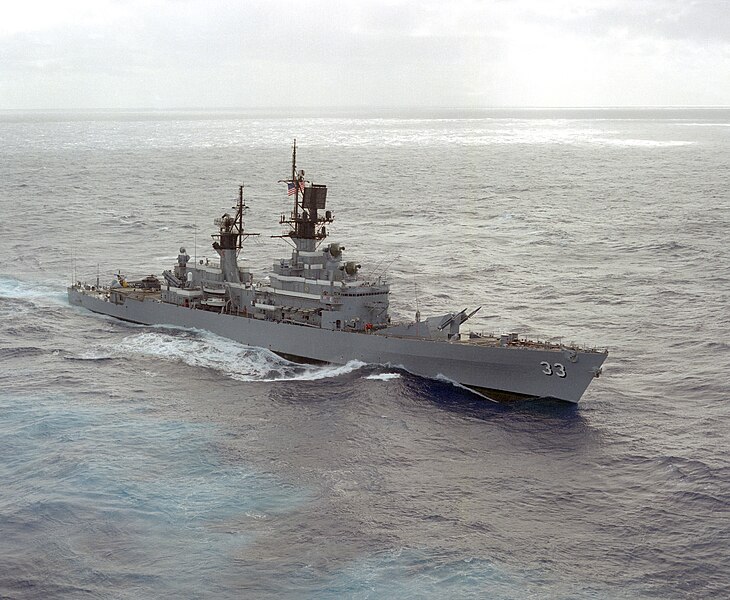
USS Fox was launched on 21 November 1964 and commissioned on 28 May 1966 at Long Beach Naval Shipyard. She was at San Diego on 6 October 1966 and became the first Pacific Fleet fleet vessel with a dual purpose launcher. She was mobilized for Vietnam, North Vietnam as SAR and PIRAZ ship, monitoring some 200 Navy and Air Force missions. On 23 October 1967 she vectored two F-4 fighters from USS Constellation which downed a MIG-21 over Hanoi. This was a first in the USN and she earned a Meritorious Unit Commendation, accepted by Captain R.O. Whelander.
On 11 January 1972, she did the job herself, firing two RIM-2 Terrier at another MiG-21 over near Vinh, but missed. In 1972, she supported CNO Project DV-98 LAMPS. She would later earn the GOLD “E” for 5 years of operations in Vietnam.
Afterwards she was deployed in the Red Sea from March 1976. She was on alert in the Persian Gulf by November 1980 and present during the Iran-Iraq war, escorting reflagged Kuwaito oil tankers in the Strait of Hormuz. In 1987 in such mission she earned a second Meritorious Unit Commendation.
In total during her career she made 15 combat deployments. She won also three Battle “E” Ribbons, two Navy Expeditionary Medals, two National Defense Service Medals, Vietnam Service Medal with two bronze stars and Southwest Asia Service Medal with bronze star as well as the Sea Service Deployment Ribbons and Republic of Vietnam Campaign Medal.
She had a final shipyard overhaul in 1989 with NTU upgrade.
Her last deployment was concluded by 1993 and she started her inactivation, decommissoned by mid-April 1994 and placed in the Inactive Ship Facility in Suisun Bay, California. She was sold for scrap by 2006 at International Shipbreaking in Brownsville, Texas.
 Biddle DLG-34
Biddle DLG-34
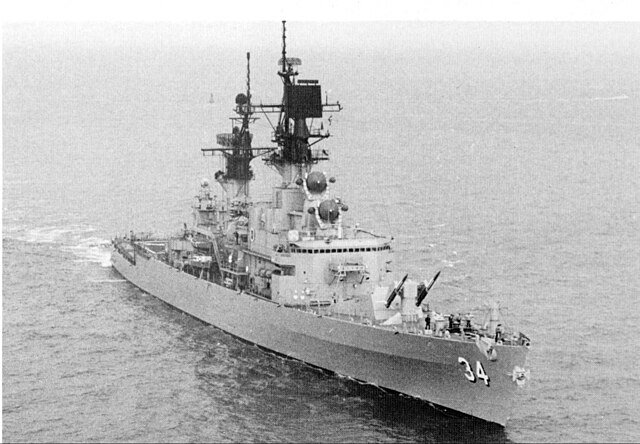
USS Biddle was laid down at Bath Iron Works in Maine, 9 December 1963, launched on 2 July 1965, commissioned on 21 January 1967 (named after Captain Nicholas Biddle, Continental Navy). After 5 months and final acceptance trials, shakedown of Cuba completed on 29 May she sailed to Boston on 2 June for post-shakedown availability until 30 October, homeported to Norfolk. She started exercises on 7 November.
Vietnam
On 22 January 1968 she departd for the Panama Canal, stopped at Pearl Harbor and Guam, then Subic Bay (24 February) and Tonkin Gulf on 3 March, entering Danang on 5 March and started her PIRAZ station for 4 months, alternated to AAW picket, and SAR vessel with stops at Subic Bay or Yokosuka.
On 14 July she stayed in the Philippines for R&R in July and set sail for home, completing her circumnavigation via Singapore, Lourenco Marques, Cape Verde, Lisbon, Copenhagen and Norfolk (12 September). She later trained in the West Indies.
13 January 1969 saw her sailing to Philadelphia for advanced safety training and back. More exercises followed and she loaded weapons at Yorktown on 30 April. On 26 May she departed via Panama Canal to Pearl Harbor (10-12 June), Guam (for fuel) and Subic Bay, then South Vietnam, Danang (30 June) and relieving USS Chicago on 1 July as strike-support/SAR ship. Apart rescuing several North Vietnamese fishermen adrift this was pretty uneventful. She left her station to Chicago on 1 August and spent tile in Subic Bay and Manila, then back on 13 August, relieving Chicago again as PIRAZ and herself relieved by USS Jouett. She had a refit in Yokosuka and disembarked her helicopters in Subic Bay.
She was back on Yankee Station on 2 October and operated as flagship coordinator for ComDesRon 3 for TF 77 and PIRAZ/SAR, relieved by USS Long Beach on 27 October. After R&R at Hong Kong and returning to Subic Bay she made another TOD in Vietnam from 7 November as plane guard for USS Coral Sea. On 13 November she made for home via Guam, San Francisco and Norfolk on 21 December.
Early 1970 saw inspections and modifications and on 13 April, she sailed for Caribbean training-evaluation followed by a regular overhaul in Norfolk from 31 July until mid-January 1971. After trials off the Virginia Capes she departed Norfolk for refresher training and later took part in NATO seapower review.
She was modified to carry a LAMPS helicopter and by 12 April departed for southeast Asia, entering the combat zone on 14 May, relieving USS Sterett, northern SAR station for a month and directing air raids, and in Subic Bay on 26 June. Later she pivoted to the northern SAR station, relieving USS Sterett on 13 July as PIRAZ ship. The night of 19 July saw five MiGs attacking her in two raids. She downed one with Terrier missiles with a possible kill in the second attack, credited to her gun batteries. She drove off the others, with no hit or damage. This even was flagged as the largest aerial attack on an US Navy ship since ww2.
Biddle remained on station SAR/IRAZ until August, had R&R in Hong Kong, stopped at Subic Bay and moved to the northern SAR station on 22 August, relieved by USS Long Beach on 17 September, setting for home via Guam, Pearl Harbor, and San Diego, arriving on 26 October. She stayed in local waters the following years, learnign of the end of the war in 1973. By the fall of 1973 she took part in a joint exercise, Atlantic Fleet and with the RCAN.
Mediterranean and Atlantic
She departed on 14 June 1974 for her first Mediterranean TOD at Rota, Spain to relieve USS Conyngham. On 26 June she joined TG 60.2. Off Cyprus on 22 July she joined special operations in the north of Crete and west as on 19 August, the US ambassador to Cyprus was assassinated, with the special task group she helped the evacuation of American citizens. She was in Naples. But while underway out of the wity her main feed pump in the forward engine room failed catastrophically, stopping the port propeller while as full flank speed on starboard and she turned so sharply to port she as partially flooded via her ventilators. She had repairs at Naples and returned to the eastern Mediterranean, looking for survivors of TWA Boeing 707. Later she transosted via the Straits of Bosporus and Dardanelles into the Black Sea for five days. After further Training, port visits she returned to Rota, and Norfolk on 14 December.
In 1975 she had an extended overhaul at Bath, Maine, which ended on 15 March 1976, completed on Bayonne, New Jersey, 17 March for completion in drydock. On 24 April, she returned to Norfolk and loaded ordnance at Yorktown then proceeded to post-overhaul tests, drills, refresher training before sailing to northern Europe and the Baltic Sea via Scapa Flow on 14 September 1976. She was in Norwegian waters and visited Copenhagen followed by a multi-national exercise in the Baltic Sea, visiting Hamburg, Antwerp, Cherbourg and at home by 9 November. In 1977, she stayed in home waters and West Indies. The rest of the year she headed for the Mediterranean, until 22 December, back in Norfolk.
In 1978, she had inspections and examinations and trained off New England-West Indies, then a third Mediterranean via Lisbon on 14 October, relieving her sister USS Harry E. Yarnell. She operated with TG 60.2, passed the Dardanelles, entered the Black Sea and on 22-27 November, was in Constanta, Romania for a goodwill visit. She was back in Norfolk on 5 April.
Next were exercises with the 2d Fleet and working with the Naval Academy and NROTC midshipmen. She had a regular overhaul in Philadelphia for the remainder of 1979 and 1980.
After trials and refresher training until 6 April 1981 she operated off the Virginia Capes-West Indies. On 4 August, she returned to the 6th Fleet (Mediterranean) directly via Gibraltar on 11 August. She was in the Gulf of Sidra, Libyan coast. Later she again entered the Black Sea. By mid-October she was off the northern coast of Egypt after the assassination of President Anwar Sadat. She was relieved by USS Coontz on 23 October and via Rota came back home on 8 November. In 1982 there was the same routine between the east coast and 6th Fleet. By mid-July, she was on PIRAZ station, eastern Mediterranean for the USMC ashore in Lebanon. She transited the Dardanelles for Black Sea until 5 August, anchored at Istanbul.
On 9 August 1982, she supported the contingency force off Lebanon, escorted PLO refugees leaving Beirut for Tunisia on the SS Sol Phryne. After Lebanon PIRAZ and a visit to Athens, she met USS Nimitz in the Gulf of Sidra until December and back home.
The routine repeated in 1983 and on 26 May, she took part in NATO Exercise “United Effort/ Ocean Safari 83.” She operated in the Baltic Sea, stopped in Leith, Scotland, and joined USN-RN exercises. She was in Norfolk on 5 August and from October was in selected restricted availability until late 1983.
In October 1985 she returned to the Mediterranean, USS Coral Sea battle group, then USS Saratoga, transiting Suez into the Indian Ocean and North Arabian Sea. By January 1986 she stopped at Diego Garcia, later learning of President Reagan’s address to President Muammar al-Gaddafi for Xmas Day airport bombings in Europe. Saratoga and Coral Sea made a combined carrier battle group for their actions in the Gulf of Sidra resulting in just three Libyan patrol boats attacked and sunk. USS America joined in with RADM Jeremy “Mike” Boorda aboard. The formation later eaned a Navy Unit Commendation.
After five uneventful stations, USS Biddle was back in Norfolk by May 1986, being awarded the Navy Expeditionary Medal. Next she was overhauled at Philadelphia, first to accept the NTU package. She trained in home waters and was deployed to the Middle East by September 1990, Operation Desert Shield, in the Saratoga battle group, Red Sea. She made 27 boardings and four diversions but her rudder broke off and sank to the bottom of the Red Sea. She received a replacement rudder via an USAF C-5B to Toulon in France with repairs made in this Shipyard. She was back to the northern Red Sea, boarding more freighters and seize one. This was her last mission as she was decommissioned and stricken on 30 November 1993, sold for scrap on 4 December 2000 after some reseve period.
Note: First Published August, 08, 2017
Read More/Src
Books
Links
on en.wikipedia.org/
navypedia.org/ us_cr_belknap.htm
seaforces.org/
www.ussjouett.com/
navsource.org/ jouett
usshorne.net/
navsource.org/ horne
globalsecurity.org/ cg-30.htm
web.archive.org/ ktvu.com/ ‘Old Gray Lady’ Given A Death Sentence
usshorne.net/
history.navy.mil/r sterett-iii.html
sterett.net/our-history/
navsource.org william standley
history.navy.mil/ William H Standley 1971 viertnam records, declassified 1972
https://www.globalsecurity.org cg-32.htm
http://www.cg-32.com/
http://www.history.navy.mil/ william_h_standley.htm
Videos
Model Kits
Main query – not a lot: USS Belknap CG-26 / USS Fox CG-33 by The Scale Shipyard 1:96, Belknap Class CG by JAG 1:700, USS Horne CG-30 1985 by Iron Shipwrights 1:350. Review of the JAG kit.

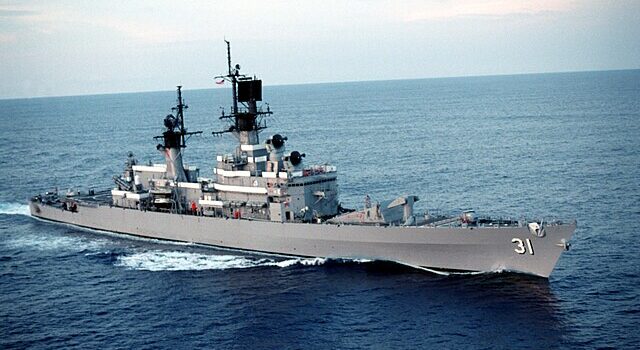
 Latest Facebook Entry -
Latest Facebook Entry -  X(Tweeter) Naval Encyclopedia's deck archive
X(Tweeter) Naval Encyclopedia's deck archive Instagram (@navalencyc)
Instagram (@navalencyc)





 Austrian Navy
Austrian Navy French Navy
French Navy Royal Navy
Royal Navy Armada Espanola
Armada Espanola K.u.K. Kriegsmarine
K.u.K. Kriegsmarine Dansk Marine
Dansk Marine Nautiko Hellenon
Nautiko Hellenon Koninklije Marine 1870
Koninklije Marine 1870 Marinha do Brasil
Marinha do Brasil Osmanlı Donanması
Osmanlı Donanması Marina Do Peru
Marina Do Peru Marinha do Portugal
Marinha do Portugal Regia Marina 1870
Regia Marina 1870 Nihhon Kaigun 1870
Nihhon Kaigun 1870 Preußische Marine 1870
Preußische Marine 1870 Russkiy Flot 1870
Russkiy Flot 1870 Svenska marinen
Svenska marinen Søværnet
Søværnet Union Navy
Union Navy Confederate Navy
Confederate Navy Armada de Argentina
Armada de Argentina Imperial Chinese Navy
Imperial Chinese Navy Marinha do Portugal
Marinha do Portugal Mexico
Mexico Kaiserliche Marine
Kaiserliche Marine 1898 US Navy
1898 US Navy Russkiy Flot
Russkiy Flot French Naval Aviation
French Naval Aviation Russian Naval Aviation
Russian Naval Aviation Sovietskiy Flot
Sovietskiy Flot Royal Canadian Navy
Royal Canadian Navy Royal Australian Navy
Royal Australian Navy RNZN Fleet
RNZN Fleet Chinese Navy 1937
Chinese Navy 1937 Kriegsmarine
Kriegsmarine Chilean Navy
Chilean Navy Danish Navy
Danish Navy Finnish Navy
Finnish Navy Hellenic Navy
Hellenic Navy Polish Navy
Polish Navy Romanian Navy
Romanian Navy Turkish Navy
Turkish Navy Royal Yugoslav Navy
Royal Yugoslav Navy Royal Thai Navy
Royal Thai Navy Minor Navies
Minor Navies Albania
Albania Austria
Austria Belgium
Belgium Columbia
Columbia Costa Rica
Costa Rica Cuba
Cuba Czechoslovakia
Czechoslovakia Dominican Republic
Dominican Republic Haiti
Haiti Hungary
Hungary Honduras
Honduras Estonia
Estonia Iceland
Iceland Eire
Eire Equador
Equador Iran
Iran Iraq
Iraq Latvia
Latvia Liberia
Liberia Lithuania
Lithuania Mandchukuo
Mandchukuo Morocco
Morocco Nicaragua
Nicaragua Persia
Persia San Salvador
San Salvador Sarawak
Sarawak Uruguay
Uruguay Venezuela
Venezuela Zanzibar
Zanzibar Warsaw Pact Navies
Warsaw Pact Navies Bulgaria
Bulgaria Hungary
Hungary

 Bundesmarine
Bundesmarine Dutch Navy
Dutch Navy Hellenic Navy
Hellenic Navy Marina Militare
Marina Militare Taiwanese Navy
Taiwanese Navy Chinese Navy
Chinese Navy Indian Navy
Indian Navy Indonesian Navy
Indonesian Navy JMSDF
JMSDF North Korean Navy
North Korean Navy Philippines Navy
Philippines Navy ROKN
ROKN IDF Navy
IDF Navy Royal New Zealand Navy
Royal New Zealand Navy Egyptian Navy
Egyptian Navy South African Navy
South African Navy

































 RN
RN
 Marine Nationale
Marine Nationale
 Soviet Navy
Soviet Navy
 dbodesign
dbodesign
For updating this post of the Belknap class. None of these cruisers survived, all were scrapped or were sank as target.
You nailed it. This is an old translated article i made 15 years ago based on Conways 1947-1995 volume. Soon it will be expanded, updated and rewritten from top to bottom, be sure of that 😉
Cheers